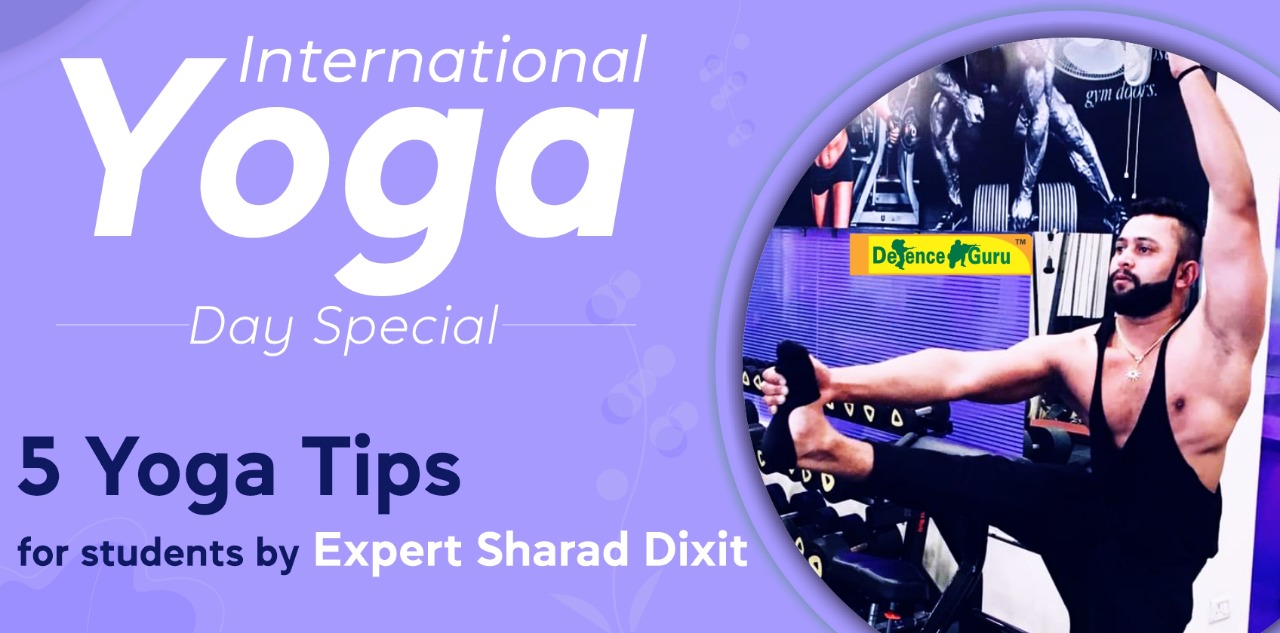International Yoga Day Special, 5 Yoga Tips For Students by Expert Sharad Dixit
“Go from a human being doing yoga to a human being yoga.”
This International Yoga Day we bring you some treasured advice from Mr. Sharad Dixit, the founder of “Sharad Dixit Yoga and Fitness Academy”. He is an expert in yogic sciences and a philanthropist, keen towards physical fitness. Anyone who does yoga will tell you that it’s more than just difficult poses and positive affirmations; it’s not about incense and frills. Yoga is a lifestyle and approach to positivity which seeks to enlighten the spirit and attune body and mind. Yoga is a way to express love to your own being, to your own soul. Mr. Dixit philosophizes his love for yoga by mentioning that yoga makes you aware of your being and embrace it with open arms; to fly towards a secret sky, to cause a hundred veils to fall open each moment. First, to let go of the chaos in life. Finally, to take a step without using your feet.
मानव जीवन में योग के कई सकारातà¥à¤®à¤• दृषà¥à¤Ÿà¤¿à¤•à¥‹à¤£ हैं, जो आतà¥à¤®à¤¾ और शरीर को समायोजित करने का पà¥à¤°à¤¯à¤¾à¤¸ करते हैं। शà¥à¤°à¥€ दीकà¥à¤·à¤¿à¤¤ ने योग के पà¥à¤°à¤¤à¤¿ अपने विचारों का उलà¥à¤²à¥‡à¤– करते हà¥à¤ कहा कि योग अपनी आतà¥à¤®à¤¾ के पà¥à¤°à¤¤à¤¿ पà¥à¤°à¥‡à¤® वà¥à¤¯à¤•à¥à¤¤ करने का à¤à¤• माधà¥à¤¯à¤® है जो आपको अपने असà¥à¤¤à¤¿à¤¤à¥à¤µ के बारे में जागरूक करता है। योग करने से हमारा शरीर सà¥à¤µà¤¸à¥à¤¥, निरोग और बलवान बनता है जिससे हमें शारीरिक तथा मानसिक लाठमिलता है। योग और योगाà¤à¥à¤¯à¤¾à¤¸ करने से हमें कई रोगों से लड़ने की शकà¥à¤¤à¤¿ à¤à¥€ मिलती है तथा यह मधà¥à¤®à¥‡à¤¹ जैसी बीमारी का इलाज करने में à¤à¥€ सहायक है। शरीर, मन और आतà¥à¤®à¤¾ को नियंतà¥à¤°à¤¿à¤¤ कर संतà¥à¤²à¤¨ बनाने में à¤à¥€ योग की अहम à¤à¥‚मिका है। योग के चार बà¥à¤¨à¤¿à¤¯à¤¾à¤¦à¥€ सिदà¥à¤§à¤¾à¤‚त हैं जो योग की उपचार पà¥à¤°à¤£à¤¾à¤²à¥€ की शिकà¥à¤·à¤¾à¤“ं और पà¥à¤°à¤¥à¤¾à¤“ं के आधार पर निमà¥à¤¨à¤µà¤¤ हैं।
Yoga is a form of mind-body fitness that involves a combination of muscular activity and an internally directed mindful focus on awareness of the self, the breath, and energy. Four basic principles underlie the teachings and practices of yoga's healing system.
-
The first principle is the human body is a holistic entity composed of various interrelated dimensions inseparable from one another and the health or illness of any one dimension affects the other dimensions.
-
The second principle is individuals and their needs are unique and therefore must be approached in a way that acknowledges this individuality and their practice must be tailored accordingly.
-
The third principle is yoga is self-empowering; the student is his or her own healer. Yoga engages the student in the healing process; by playing an active role in their journey toward health, the healing comes from within, instead of from an outside source and a greater sense of autonomy is achieved.
-
The fourth principle is that the quality and state of an individual’s mind is crucial to healing. When the individual has a positive mind-state healing happens more quickly, whereas if the mind-state is negative, healing may be prolonged.
Yoga encourages one to relax, slow the breath and focus on the present, shifting the balance from the sympathetic nervous system and the flight-or-fight response to the parasympathetic system and the relaxation response. The latter is calming and restorative; it lowers breathing and heart rate, decreases blood pressure, lowers cortisol levels, and increases blood flow to the intestines and vital organs. One of the main goals of yoga is to achieve tranquility of the mind and create a sense of well-being, feelings of relaxation, improved self-confidence, improved efficiency, increased attentiveness, lowered irritability, and an optimistic outlook on life.
योग वà¥à¤¯à¤•à¥à¤¤à¤¿ को वरà¥à¤¤à¤®à¤¾à¤¨ पर धà¥à¤¯à¤¾à¤¨ केंदà¥à¤°à¤¿à¤¤ करने और विशà¥à¤°à¤¾à¤® पà¥à¤°à¤¤à¤¿à¤•à¥à¤°à¤¿à¤¯à¤¾ को पà¥à¤°à¥‹à¤¤à¥à¤¸à¤¾à¤¹à¤¿à¤¤ करने में मदद करता है। यह शà¥à¤µà¤¾à¤¸ और हृदय गति को संतà¥à¤²à¤¿à¤¤ करता है, रकà¥à¤¤à¤šà¤¾à¤ª को कम करता है तथा कोरà¥à¤Ÿà¤¿à¤¸à¥‹à¤² के सà¥à¤¤à¤° को à¤à¥€ कम करने में मदद करता है। योग करने के और à¤à¥€ कई लाठहैं, यह आंतों और महतà¥à¤µà¤ªà¥‚रà¥à¤£ अंगों में रकà¥à¤¤ के पà¥à¤°à¤µà¤¾à¤¹ को बढ़ाता है, मन को शांति पà¥à¤°à¤¦à¤¾à¤¨ करता है और आतà¥à¤®à¤µà¤¿à¤¶à¥à¤µà¤¾à¤¸ का सà¥à¤¤à¤° बढ़ाकर जीवन को à¤à¤• आशावादी दृषà¥à¤Ÿà¤¿à¤•à¥‹à¤£ पà¥à¤°à¤¦à¤¾à¤¨ करता है।
Mr. Sharad Dixit mentions the theology of the following five yogic asans :
1- SURYANAMASKAR OR SUN SALUTATIONS- Traditionally performed in the morning to greet the new day. This sequence of postures can be a complete practice in itself or can prepare you for a longer asana routine. It is as rich in symbolic and mythic overtones as it is in physical benefits.
-
सूरà¥à¤¯à¤¨à¤®à¤¸à¥à¤•à¤¾à¤° अपने आप में à¤à¤• संपूरà¥à¤£ अà¤à¥à¤¯à¤¾à¤¸ है जो सà¤à¥€ मà¥à¤–à¥à¤¯ आसनों को समायोजित करता है तथा आपको à¤à¤• लंबी और सकà¥à¤°à¤¿à¤¯ दिनचरà¥à¤¯à¤¾ के लिठतैयार करता है। सूरà¥à¤¯ का पà¥à¤°à¤•à¤¾à¤¶ लंबे समय से चेतना और आतà¥à¤®-रोशनी का पà¥à¤°à¤¤à¥€à¤• रहा है। इस गतिशील आसन के माधà¥à¤¯à¤® से सूरà¥à¤¯ को समà¥à¤®à¤¾à¤¨à¤¿à¤¤ करने के साथ-साथ सà¤à¥€ मà¥à¤–à¥à¤¯ आसनों का अà¤à¥à¤¯à¤¾à¤¸ à¤à¤• साथ किया जाता है।
-
In many cultures, light has long been a symbol of consciousness and self-illumination. One of the means of honoring the sun is through this dynamic asana. Each Sun Salutation begins and ends with the joined-hands mudra (gesture) touched to the heart. This placement is no accident; only the heart can know the truth.
2- VRIKSHASANA OR TREE POSE- Vrikshasana or Tree Pose is a balancing asana. It is one of the very few standing poses in medieval hatha yoga, and remains popular in modern yoga as exercise. Vrikshasana replicates the graceful, steady stance of a tree.
-
वृकà¥à¤·à¤¾à¤¸à¤¨ à¤à¤• संतà¥à¤²à¤¨à¤•à¤¾à¤°à¥€ आसन है तथा यह मधà¥à¤¯-यà¥à¤— के हठयोग में वृकà¥à¤· के समान खड़े होकर अà¤à¥à¤¯à¤¾à¤¸ किये जाने वाले आसनों में से à¤à¤• है। वृकà¥à¤·à¤¾à¤¸à¤¨ पैरों को मजबूत करता है तथा शरीर में संतà¥à¤²à¤¨ और धीरज धारण करने में à¤à¥€ मदद करता है जिससे सतरà¥à¤•à¤¤à¤¾ और à¤à¤•à¤¾à¤—à¥à¤°à¤¤à¤¾ में सà¥à¤§à¤¾à¤° होता है।
-
Unlike most yoga poses, this pose requires keeping our eyes open in order to maintain body balance. It strengthens the legs, and opens the hips and improves your neuromuscular coordination. It also helps with balance and endurance thus improving alertness and concentration.
3- NATARAJ ASAN- It is an advanced balance pose that brings grace, peace of mind and clarity. The pose is additionally a deep backbend that requires great strength in the entire front line of the body.
-
यह आसन à¤à¤• उनà¥à¤¨à¤¤ संतà¥à¤²à¤¨ मà¥à¤¦à¥à¤°à¤¾ है जो मन की शांति और सà¥à¤ªà¤·à¥à¤Ÿà¤¤à¤¾ के लिठसरà¥à¤µà¥‹à¤¤à¥à¤¤à¤® आसन है। यह आसन सौंदरà¥à¤¯, खिंचाव, संतà¥à¤²à¤¨ और à¤à¤•à¤¾à¤—à¥à¤°à¤¤à¤¾ विकसित करता है।
-
The Front Line of the body extends from the quadriceps, through the hips, abdominals, chest and even the front of the throat. The name comes from the Sanskrit words nata meaning "dancer", raja meaning "king", and asana meaning "posture" or "seat". Nataraja is one of the names given to the Hindu God Shiva in his form as the cosmic dancer. This aesthetic, stretching and balancing asana develops concentration and grace.
4- GYAAN MUDRA - The Gyan Mudra stimulates the root chakra, easing tension and depression. It relates to expansion and knowledge. It is extremely calming and brings the practitioner spiritual openness and ease in meditation.
-
जà¥à¤žà¤¾à¤¨ मà¥à¤¦à¥à¤°à¤¾ आसन मूल चकà¥à¤° को उतà¥à¤¤à¥‡à¤œà¤¿à¤¤ करता है तथा तनाव और अवसाद को कम करने में à¤à¥€ मदद करता है। यह आसन विसà¥à¤¤à¤¾à¤° और जà¥à¤žà¤¾à¤¨ से संबंधित है और आधà¥à¤¯à¤¾à¤¤à¥à¤®à¤¿à¤• धà¥à¤¯à¤¾à¤¨ में सहजता लाता है।
-
Gyan mudra, otherwise known as chin mudra, is a sacred hand gesture or ‘seal’ used to direct energy and maintain focus. Gyan mudra is one of the most important and well known mudras, found across Buddhist, Hindu and Yoga traditions alike. Gyan is Sanskrit for ‘knowledge’ or ‘wisdom,’ and so this gesture is sometimes referred to as the Mudra of Knowledge. Gyan mudra is traditionally practiced whilst in seated meditation, although some modern day practitioners are known to use it whilst holding standing asana.
5- TRATAKA - Trataka is a yogic purification (a shatkarma) and a tantric method of meditation that involves staring at a single point such as a small object, black dot or candle flame. It is said to bring energy to the "third eye" (ÄjÅˆÄ chakra) and promote various psychic abilities.
-
यह योगिक धà¥à¤¯à¤¾à¤¨ की à¤à¤• तांतà¥à¤°à¤¿à¤• विधि है जिसमें किसी छोटी वसà¥à¤¤à¥ जैसे मोमबतà¥à¤¤à¥€ की लौ या à¤à¤• बिंदॠको देखना होता है। à¤à¤¸à¤¾ कहा जाता है कि यह आसन विà¤à¤¿à¤¨à¥à¤¨ मानसिक कà¥à¤·à¤®à¤¤à¤¾à¤“ं को और सà¥à¤®à¥ƒà¤¤à¤¿ की शकà¥à¤¤à¤¿ को बढ़ाता है तथा मन को जागरूक कर धà¥à¤¯à¤¾à¤¨ की सà¥à¤¥à¤¿à¤¤à¤¿ में लाता है।
-
By fixing the gaze the restless mind too comes to a halt. Some modern people believe that the control of the ciliary (blink) reflex stimulates the pineal gland, which Kundalini Yoga identifies with the third eye. Traá¹aka is said to enhance the ability to concentrate. It increases the power of memory and brings the mind to a state of awareness, attention and focus.
These were some important asans Mr. Dixit told us about. He mentioned that there is so much still unknown to the world about yoga, all we have managed to gather is merely a drop in the ocean. The philosophy of yoga teaches that each of us replicates the world at large, embodying rivers, seas, mountains, fields, stars and planets-the sun and the moon. The outer sun is in reality a token of our own inner sun which corresponds to our subtle, or spiritual, heart. Here is the seat of consciousness and higher wisdom and, in some traditions, the domicile of the embodied self. The theory places the seat of wisdom in the heart, which we typically associate with our emotions, and not the brain. But in yoga, the brain is actually symbolized by the moon, which reflects the sun’s light but generates none of its own. This kind of knowledge is worthwhile for dealing with mundane affairs, and is even necessary to a certain extent for the lower stages of spiritual practice. But in the end, the brain is inherently limited in what it can know and is prone to misconception or false knowledge of the self.
Lastly, Mr. Dixit wishes each one of you a very happy international yoga day and encourages you to adapt yoga in your daily lives. Do pay a visit to Sharad Dixit Yoga and Fitness Academy for further details or contact him directly on+91 8853369999.
For More Yoga Tips From Our Expert Mr. Sharad Dixit
Sharad Dixits' Yoga Academy Lucknow
Email : sharadk929@gmail.com
Contact :- +918853369999
Read More About Mr. Sharad Dixit, Top Yoga Instructor From Lucknow

















